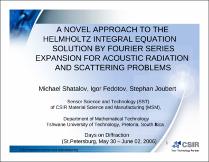 ResearchSpace
ResearchSpace
Novel approach to the Helmholtz integral equation solution by Fourier series expansion for acoustic radiation and scattering problems
JavaScript is disabled for your browser. Some features of this site may not work without it.
- ResearchSpace
- →
- Research Publications/Outputs
- →
- Conference Publications
- →
- View Item
| dc.contributor.author |
Shatalov, MY

|
|
| dc.contributor.author |
Fedotov, I

|
|
| dc.contributor.author |
Joubert, S

|
|
| dc.date.accessioned | 2009-01-19T14:32:12Z | |
| dc.date.available | 2009-01-19T14:32:12Z | |
| dc.date.issued | 2006 | |
| dc.identifier.citation | Shatalov, MY, Fedotov, I and Joubert, S. 2006. Novel approach to the Helmholtz integral equation solution by Fourier series expansion for acoustic radiation and scattering problems. Days on Diffraction, St. Petersburg, Russia, 30 May – 02 June 2006, pp 19 | en |
| dc.identifier.uri | http://hdl.handle.net/10204/2846 | |
| dc.description.abstract | Conventional methods of solution of the Helmholtz integral equation consist in discretization of a radiating/scattering boundary on multiple boundary elements, assumption of a smooth distribution of the velocity potential on every element and transforming of the original problem to a system of linear algebraic equations. This method needs a large amount of time consuming calculations in the case when the radiating/scattering surface is large and the frequency of the acoustic field could not be considered as low or high and belongs to an “intermediate” frequency range. Analysis of these effects is practically impossible on a conventional PC due to the number of boundary elements, which are necessary to spread over the surface of the large-scale structure to guarantee the numerical accuracy of solution. In the present paper the authors propose to use a novel method of solution of the Helmholtz integral equation, which is based on expansion of the integrands in double Fourier series. The main difficulty of realization of the Fourier series approach is that the kernels of this equation do not satisfy to the Dirichlet’s theorem and hence, could not be directly expanded into Fourier series. To overcome the abovementioned difficulty the authors represent the Helmholtz integral as sum of the integral with modified kernel, which satisfy the Dirichlet’s theorem and so could be expanded in the Fourier series, and an additional integral in the vicinity of the point of singularity. This approach helps to substantially reduce the volume of calculations, takes advantage of fast discrete Fourier transformations and achieves a substantial progress in solution of acoustic radiation and scattering problems. The typical example of scattering of an obliquely incident plane wave by a large-scale structure composed by a cylinder with two hemispherical end caps is considered | en |
| dc.language.iso | en | en |
| dc.subject | Helmholtz integral equation | en |
| dc.subject | Spherican coordinates | en |
| dc.subject | Acoustic wave scattering | en |
| dc.title | Novel approach to the Helmholtz integral equation solution by Fourier series expansion for acoustic radiation and scattering problems | en |
| dc.type | Conference Presentation | en |
| dc.identifier.apacitation | Shatalov, M., Fedotov, I., & Joubert, S. (2006). Novel approach to the Helmholtz integral equation solution by Fourier series expansion for acoustic radiation and scattering problems. http://hdl.handle.net/10204/2846 | en_ZA |
| dc.identifier.chicagocitation | Shatalov, MY, I Fedotov, and S Joubert. "Novel approach to the Helmholtz integral equation solution by Fourier series expansion for acoustic radiation and scattering problems." (2006): http://hdl.handle.net/10204/2846 | en_ZA |
| dc.identifier.vancouvercitation | Shatalov M, Fedotov I, Joubert S, Novel approach to the Helmholtz integral equation solution by Fourier series expansion for acoustic radiation and scattering problems; 2006. http://hdl.handle.net/10204/2846 . | en_ZA |
| dc.identifier.ris | TY - Conference Presentation AU - Shatalov, MY AU - Fedotov, I AU - Joubert, S AB - Conventional methods of solution of the Helmholtz integral equation consist in discretization of a radiating/scattering boundary on multiple boundary elements, assumption of a smooth distribution of the velocity potential on every element and transforming of the original problem to a system of linear algebraic equations. This method needs a large amount of time consuming calculations in the case when the radiating/scattering surface is large and the frequency of the acoustic field could not be considered as low or high and belongs to an “intermediate” frequency range. Analysis of these effects is practically impossible on a conventional PC due to the number of boundary elements, which are necessary to spread over the surface of the large-scale structure to guarantee the numerical accuracy of solution. In the present paper the authors propose to use a novel method of solution of the Helmholtz integral equation, which is based on expansion of the integrands in double Fourier series. The main difficulty of realization of the Fourier series approach is that the kernels of this equation do not satisfy to the Dirichlet’s theorem and hence, could not be directly expanded into Fourier series. To overcome the abovementioned difficulty the authors represent the Helmholtz integral as sum of the integral with modified kernel, which satisfy the Dirichlet’s theorem and so could be expanded in the Fourier series, and an additional integral in the vicinity of the point of singularity. This approach helps to substantially reduce the volume of calculations, takes advantage of fast discrete Fourier transformations and achieves a substantial progress in solution of acoustic radiation and scattering problems. The typical example of scattering of an obliquely incident plane wave by a large-scale structure composed by a cylinder with two hemispherical end caps is considered DA - 2006 DB - ResearchSpace DP - CSIR KW - Helmholtz integral equation KW - Spherican coordinates KW - Acoustic wave scattering LK - https://researchspace.csir.co.za PY - 2006 T1 - Novel approach to the Helmholtz integral equation solution by Fourier series expansion for acoustic radiation and scattering problems TI - Novel approach to the Helmholtz integral equation solution by Fourier series expansion for acoustic radiation and scattering problems UR - http://hdl.handle.net/10204/2846 ER - | en_ZA |





